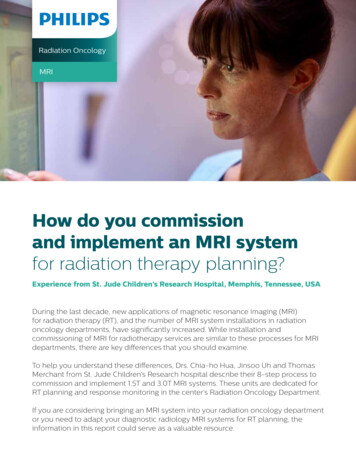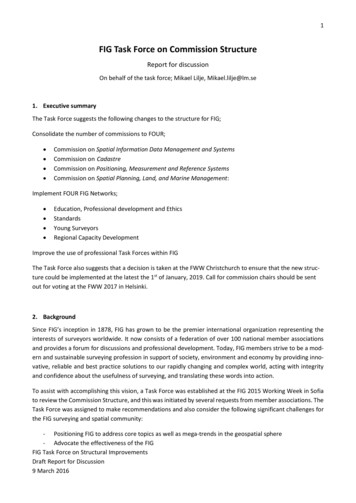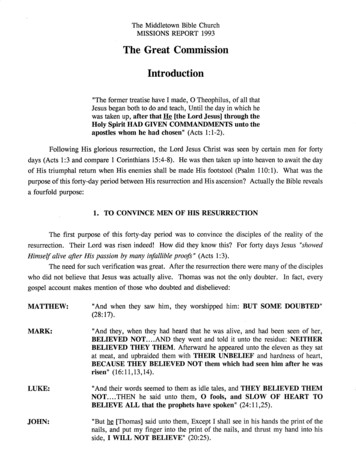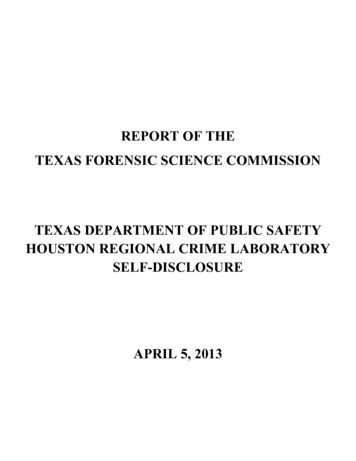
Transcription
Radiation OncologyMRIHow do you commissionand implement an MRI systemfor radiation therapy planning?Experience from St. Jude Children’s Research Hospital, Memphis, Tennessee, USADuring the last decade, new applications of magnetic resonance imaging (MRI)for radiation therapy (RT), and the number of MRI system installations in radiationoncology departments, have significantly increased. While installation andcommissioning of MRI for radiotherapy services are similar to these processes for MRIdepartments, there are key differences that you should examine.To help you understand these differences, Drs. Chia-ho Hua, Jinsoo Uh and ThomasMerchant from St. Jude Children’s Research hospital describe their 8-step process tocommission and implement 1.5T and 3.0T MRI systems. These units are dedicated forRT planning and response monitoring in the center’s Radiation Oncology Department.If you are considering bringing an MRI system into your radiation oncology departmentor you need to adapt your diagnostic radiology MRI systems for RT planning, theinformation in this report could serve as a valuable resource.
In 2016, the Radiation Oncology Department at St. JudeChildren’s Research Hospital (Memphis, Tennessee,USA) installed two Philips Ingenia MR-RT wide-bore(70 cm) MRI systems. These scanners are dedicated forRT planning and therapy response monitoring (i.e., ontreatment monitoring). The 1.5T system is located in thephoton therapy area and the 3.0T system is in the protontherapy center. Medical physicist Dr. Chia-ho Hua led thecommissioning project.Chia-ho Hua, PhD is a board-certifiedmedical physicist and faculty member of1. System acceptance testingAccording to our hospital’s system handover requirements,Philips engineers included specific acceptance tests andproduced an installation acceptance test document (IATD) oncompletion of system installation.Table 1 lists the customized acceptance tests performedat St. Jude. We defined the performance criteria based onAmerican College of Radiology (ACR) MRI Quality ControlManual1 guidelines, the American Association of Physicistsin Medicine (AAPM) report No. 1002 and on vendor technicalsince 2005. His research areas includetherapy to minimize normal tissue toxicityFor ACR-specified tests, we used the ACR MRI accreditationphantom and the standard head coil (dStream Head coil),along with ACR specified sequences, as the performancecriteria are established in the MRI community for head coils.Institution-Defined Performance Criteria andSource (AAPM/ACR/Philips)Measured Performance MethodB0 magnetic fieldhomogeneityInhomogeneity 0.45 ppm rms for 40-cm DSV, 0.08 ppm rms for 30-cm DSV, 0.022 ppm rmsfor 20-cm DSV (Philips)24-plane homogeneity plot after finalshimming during installation by PhilipsMagnetic field driftDrift 1 ppm/day (AAPM)Record the center frequency determined bymorning Periodic Image Quality Test (PIQT)quality assurance for a period of 14 daysTransmitter gaincalibrationMaximum signal intensity is demonstrated with90 spin nutation (AAPM)Measure SNR on spin echo or gradient echoimages of 100 mm bottle phantom at theisocenter with different nutation anglesGeometric accuracyTypical inaccuracy 1 mm for 32-cm DSV(Philips)ACR geometric accuracy method and PhilipsMR-RT geometric distortion phantom analysisHigh-contrast spatialresolution1-mm hole size should be resolved (ACR)ACR phantom and methodSlice thickness accuracyThickness deviation should be 0.7 mm (ACR)ACR phantom and methodSlice position accuracyPosition offset 4 mm (ACR)ACR phantom and methodImage intensityuniformityPercent integral uniformity 87.5% for 1.5Tand 82% for 3.0T (ACR)ACR phantom and methodintegrating advanced medical imaging intoradiation therapy and optimizing protonBoth systems met the defined performance criteria beforeinitiation of clinical use.Test Namethe Department of Radiation Oncologyat St. Jude Children’s Research Hospital,specifications. Standard head coils (dStream Head coils) wereused whenever applicable.while improving tumor control for pediatricmalignancy.Jinsoo Uh, PhD is a medical imagingFigure 1. 1.5T and 3.0T MRI simulation rooms at St. Jude’s Children’s Research Hospital.scientist of the Department of RadiationOncology at St. Jude Children’s ResearchHospital. His research areas includedevelopment and applications of novelCommissioning an MRI system for radiotherapyPercent signal ghostingGhosting 1% (AAPM)ACR phantom and methodLow-contrast objectdetectability 9 spokes detectable for 1.5T and 37 spokesfor 3.0T (ACR)ACR phantom and methodSignal-to-noise ratio(SNR)Vendor internal criteria (Philips)SNR from flood field uniformity test in PhilipsPIQT using standard head coilEPI ghostingCoefficient of variation of the signalintensity 0.25% and ghosting ratio 3% (AAPM)AAPM report 100 methodSpectral quality ofspectroscopyPercent difference between two runs in arearatio and amplitude ratio of NAA/Cr and NAA/Cho 5%Single-voxel (20 20 20 mm) spectral dataof metabolites were evaluated with pointresolved spectroscopy (PRESS) of a tissuemimicking MRI spectroscopy phantom (GEHealthcare, Milwaukee, WI, USA)Spike noiseTrack down source of spike noise if detected perAAPM report 100Philips’ method of spike noise test by PhilipsMRI techniques for improving radiationdelivery and assessing late effects ofradiation therapy.The St. Jude team describes 8 key steps in the commissioning of the MR-RT scannersin the RT department (see Figure 2).1System acceptance testing2Patient and staff safety preparation3Calibrating the external laser bridge4Establishing MRI system baseline performance – geometric accuracyEstablishing MRI quality assuranceEddy currentcompensationVendor internal criteria5Philips’ internal Eddy current analysis byPhilips6RF coil testing and image quality in the treatment positionTable position accuracyLAP lasers and rulers7Imaging patients in the treatment positionLongitudinal travel deviation (forward andbackward) 0.5 mm (Philips)8Scan protocol (ExamCard) optimizationFigure 2. 8 key steps in commissioning an MRI system for radiotherapyTable 1. St. Jude-defined acceptance testsAbbreviations: ACR, American College of Radiology; B0, main magnetic field; DSV, diameter spherical volume; EPI, echo-planar imaging; GE, GEHealthcare, Milwaukee, WI; NAA/Cho, N-acetylaspartate-to-choline ratio; NAA/Cr, N-acetylaspartate-to-creatine ratio; ppm, parts per million; PIQT,periodic image quality test; rms, root mean square; SNR, signal-to-noise ratio.23
2. Patient and staff safety preparationStaff trainingYour center may have its own requirements for qualifyingMRI system operators, and the learning curve could be steepfor therapists and therapy physicists who have had no priorMRI training. For our department, we created a staff trainingplan with the Philips education project manager six monthsbefore clinical use. The team included an MRI registry certifiedtherapist, a department MRI physicist, radiation therapists andPhilips clinical experts. Our aim was to train the staff on thesafe use of the MRI scanners and to build competence amongthe radiation therapists in performing MRI examinations.To provide staff with ample learning opportunities and tooptimize St. Jude’s MRI ExamCards, we scheduled numerouson-site visits by Philips MRI specialists during and aftergo-live. Policies, procedures and competency tests for MRIsystem operators were developed.MRI safetyWe established the 1.5 T and 3.0 T MRI suites in safety zonefacilities, with badge access required for zones II (MRI suitepre-screening zone) to IV (the magnet room). Before installingthe magnet, the wall magnetic field shielding was designed tocontain the 5-Gauss line inside the magnet room.After magnet ramp-up, we measured the magnetic field in zoneIV and in all adjacent rooms. Ferromagnetic detectors (FerrAlertSolo prescreener and HALO II detector, KOPP DevelopmentInc., Jensen Beach, FL) were installed to locate ferrous hazardson patients before imaging and prevent patients with thosefrom entering zone III or IV areas. Staff who operate MRIsystems studied Philips online education courses and receivedtraining from Philips MRI specialists.Prior to clinical use in our department, the St. Jude MRIsafety officer inspected the facility. Before we approvedbadge access to the MRI rooms for radiation oncologyand anesthesiology staff members, they were required totake institutional online MRI safety courses and receivewalkthrough training. Annual refresher training also ismandatory. Numerous online resources are available for MRIsafety education, including American College of Radiology,International Society for Magnetic Resonance in Medicine,and the virtual library on the AAPM website3,4,5,6.MRI-compatible devicesWe placed several electronic patient monitoring devices inthe magnet rooms. An MRI-conditional anesthesia system(Fabius MRI, Drager Medical Inc., Telford, PA) – certifiedfor field strengths of up to 400 Gauss – is equipped withvisual and audio alarms that activate in areas of highmagnetic fields. Wireless MRI-conditional patient monitors(Expression, Invivo Corporation, Orlando, FL) were installedinside the magnet rooms to enable anesthesia staff toremotely monitor patients from the console area. There alsois an MRI-conditional contrast injector (Spectris Solaris EP,MEDRAD Inc., Warrendale, PA) in the room. We installeda room oxygen monitor to check for the presence of inertgases, such as helium and nitrogen, which can displaceoxygen in the magnet room. In addition, we visuallyinspected the RF shielding – where medical gas lines enterthe rooms – to ensure the shielding’s completeness andintegrity. MRI-safe aluminum oxygen tanks are provided asbackups in case of patient emergencies.3. Calibrating the external laser bridge4. Establishing MRI baseline performance –geometric accuracyThe geometric accuracy test is among the most important tests for characterizing the distortions caused mainly by gradientfield nonlinearity. The test’s primary purpose is to confirm hardware integrity, which does not depend on the imaging subjectand sequences. Before imaging, the system performs active shimming over the imaging volume to further correct theadditional perturbation introduced by bringing a patient or object into the magnet.We conducted the geometric accuracy test during acceptance testing and therapists repeat it daily with the Philips PIQTphantom, covering a head-size volume. In addition, our physicists perform a monthly evaluation of geometric accuracy withthe large Philips geometric distortion phantom. Figure 4 shows setup of the Philips QA phantom, which has an embedded gridof 9 mm markers – each 25 mm apart – that generate a high MRI signal. A 3D T1-weighted gradient echo sequence was usedfor each scan with 3D distortion correction applied.ABFigure 4. Photographs of (A) the Philips geometric distortion slab phantom on the indexed flat table top and (B) the measurement setupwith the phantom positioned in the magnet isocenter.Figure 5 shows the typical results of the geometric distortion measurements. The distortions within the ellipses (color-codediso-distortion lines) were within vendor tolerances ( 2 mm distortion at 6 cm, 3 mm at 13 cm, and 5 mm at 20 cm).Philips also specified a typical distortion of 1 mm over a 32-cm diameter spherical volume (DSV) for Ingenia MRI systems.AB1.5TWe calibrated the LAP DORADOnova laser system for patient positioning accuracy by measuring the table travel distancefrom the external laser isocenter to the magnet imaging isocenter. This was done using imaging of the internal crosshairs ofthe LAP AQUARIUS phantom, and confirming that the LAP lasers project onto the phantom external markings when the tableis retracted by that distance. We then entered the final distance in the longitudinal axis into the scanner calibration file forone-click travel-to-scan.AB3TFigure 3. Imaging test with LAP AQUARIUS phantom. (A) The phantom was placed on a leveling platform and aligned with external laser projections. (B)Nine consecutive slice images were acquired and displayed for each of the axial, sagittal and coronal planes. The slice locations of the brightest crosshairsrevealed the displacement of the phantom center relative to the magnet isocenter.4Figure 5. (A) Iso-distortion lines of geometric distortion measurements for the 3.0T MRI system. The distortionswithin the regions encompassed by the green, blue, yellow and red lines are smaller than 1 mm, 2 mm, 3 mm,and 5 mm, respectively. (B) Percentages of marker numbers within each tolerance of distortion for a sphereof a given radius from the magnet center for the 1.5T and 3.0T systems. The green curves of 1 mm distortionare 99% and 96%, respectively, for a 160 mm radius (320 mm diameter) due to the susceptibility effect of themarkers at the phantom’s bottom edge.5
5.Establishing MRI quality assuranceDaily QA confirms the basic facility integrity, the auxiliaryequipment and the external laser system. In addition, aspart of daily QA, we perform a manufacturer-provided batchprocedure (PIQT). This test measures the center frequency,SNR, spatial resolution, slice thickness, image uniformityand spatial linearity. These measurements are somewhatextensive for daily monitoring, but the fully automatedprocedure makes PIQT suitable for daily QA and has replacedweekly image quality testing.Facility and equipmentDescriptionMethodsTable positioning accuracyIn addition to the ELPS QA, the tablemovements by specific distances ( 100mm, -100 mm) are confirmedUsing a scanner system’s batchinterpreterB0 homogeneityReal and imaginary components of thephantom images in axial, sagittal, andcoronal positions are evaluatedManufacturer-provided batchprocedure with a 400-mm diameterbody phantomMagnetic field stabilityResonant frequency variation isretrospectively tracked by analyzingrecorded central frequencyRetrospective review of daily PIQTreportsTransmitter gain calibrationTo check the proper calibration ofRF transmitter gain by evaluating therelation between signal intensity andnutation angleA 100-mm diameter sphericalphantom and the 15-channel head coilare usedUltrafast imagingTest of the temporal stability, ghostingand geometric distortion of an EPIsequence.AnnualThe annual QA repeats most of the acceptance tests. Besidesthose included in the daily and monthly QA, the annual QAevaluates the advanced functionalities of the static magneticfield, RF transmission, and gradient field.DescriptionMethodsSafety signageSafety zone signs, caution and warningsigns, “Magnet On” sign and ASTM labels(MRI safe/conditional/unsafe)Visual inspectionMetal detectorsHand-held metal detectors andferromagnetic detectors mounted in ZoneII and at the entrance to Zone IVPlace a metal object near the detectorto ensure correct operationSpike noiseTo determine existence of unusualnoise originated from surroundingroom componentsOxygen monitorTo ensure the oxygen level inside the MRIroom is sufficient ( 20%)Visual inspectionEddy current compensationPatient observation systemMonitoring camera and screen, operatorpatient intercom, and nurse call pinch ballVisual inspection and test operationTo ensure optimal compensation of eddycurrent effects arising from fast switchingof gradient coilACR image qualityImage quality tests with ACR phantomLaser alignmentTo ensure all laser lines converge andeach laser line is sharp and continuousHold a piece of paper in the path ofthe beamSNR, spatial resolution, slicethickness, image uniformityand spatial linearityMonitor the system performancePeriodic image quality test (PIQT),manufacturer-provided batch processusing a 200 mm diameter headphantom and head coilRF shieldingIntegrity of the copper mesh on windowsand the copper fingers around the door tothe magnet roomVisual inspectionCryogen level andcompressorChecking the level of liquid helium inthe magnet cryostat ( 30%) and normalsound from the cryogen compressorUsing software tool on the consoleand manual inspectionExternal laser positioningsystem (ELPS)Check of consistency between laseralignment and scanner isocenterELPS QA test: ExamCard and LAPAQUARIUS phantom are used.Geometric distortionTo determine extent of distortions insidethe magnet bore by evaluating latticestructured landmark positions in thephantom imagesManufacturer-provided batchprocedure with a slab phantomSee daily QAThe methods described in the ACR MRIQuality Control Manual5 and the AAPMreport No. 1006) are followedThe 32-channel head coil is used formonthly QA while the 15-channelhead coil is used for daily and annualQA. Only ACR T1-weighted spin echoimages are evaluatedReceiver coil integritySNR and ghosting test for selectedreceiver coils of most frequent useACR phantom images with flexibleloop or anterior/posterior coils areevaluated (Fig. 6)DailyImagequalityTest ItemsImage qualityTest ItemsWe check the facility’s more general features on a monthlybasis. For example, we quantitatively evaluate the laser systemalignment against the magnet isocenter, and thoroughly testimage quality using the ACR phantom and the 32-channelhead coil. The aforementioned geometric distortion test (usinga slab phantom and external laser accuracy verification) areincluded in the monthly QA. And, because they are mostfrequently used, we also test the anterior and flexible loop coilsmonthly.Facility andequipmentWe have established a periodic MRI system quality assurance(QA) program (Table 2) based on the ACR MRI Quality ControlManual, AAPM Report 100, on manufacturers’ recommendations,and on previous reports on QA of MRI simulators. We assignedtesting frequencies (daily, monthly, or annually) appropriate tothe scope of the QA protocols in each category.Manufacturer-provided batchprocedures with designated receivercoils and phantomsSee aboveTable 2. Periodic MR system quality assurance protocols established in our departmentAbbreviation: AAPM, American Association of Physicists in Medicine; ACR, American College of Radiology; ASTM, American Society for Testing andMaterials; B0, static magnetic field; ELPS, external laser positioning system; EPI, echo planar imaging; MR, magnetic resonance; NEMA, National ElectricalManufacturers Association; PIQT, periodic image-quality test; QA, quality assurance; RF, radiofrequency; SNR, signal-to-noise ratio.Image qualityFacility andequipmentMonthly66. RF coil testing and image quality inthe treatment positionWe often use unconventional receiver coil configurations toaccommodate immobilization devices for imaging patients inRT positions. For example, we use a pair of flexible loop coilsfor cranial imaging instead of standard diagnostic phased-arrayhead coils. We were concerned that these coil configurationsmight result in inferior image quality due to fewer coil elementscompared to standard configurations. In addition, patientsare positioned somewhat further away from the posterior coilelements due to the use of a flat table top, which could alsoimpact image quality.We therefore repeated the ACR tests with the flexible loopand anterior coil configurations. We also estimated SNR usingbackground noise7, the NEMA publication). Figure 6 showsthe coil setup for the performance test. A pair of loop coilswas fastened to both sides of the phantom to simulate cranialimaging (Figure 6A). Extracranial scans on various body siteswere represented by the phantom at various locations (center,laterally shifted by 10 cm, and longitudinally shifted by 20 cm)between the flat table top and the anterior coil (Figure 6B).7
AB7. Imaging patients in the treatment positionCAt St. Jude, we believed it was imperative to duplicate thepatient positioning strategy used in our existing CT/linac/proton therapy workflow and apply it to MRI scanning.Essential to this was to test and confirm in advance that allpatient immobilization and positioning devices were MRIcompatible.Figure 6. The setup of ACR phantom for measuring image quality with RT coil configurations that emulate (A) head imaging with a pair of large flexible loopcoils and (B-C) extracranial imaging with anterior and posterior coils. The latter was performed with the phantom at several locations, including (B) themagnet isocenter, (C) 10 cm to the left, 10 cm to the right, 20 cm superiorly, and 20 cm inferiorly.Figure 7 shows the ACR and SNR test results relevant to receivercoil selection. The performance of RT coils is compared to thatof the dStream diagnostic head coils. The image-intensityuniformity was lower with coils in RT configurations: 63%-87%for RT coils vs. 95%-96% for the standard head coil for the 1.5Tsystem; and 75%-89% for RT coils vs. 87%-91% for the standardand 32-channel head coils for the 3.0T system. Althoughthe signal ghosting percentage and low-contrast objectdetectability also were lower with RT coils, they still met ACRcriteria that apply to standard head coils.AThe SNR was always higher with 3.0T than 1.5T by 15-64% forthe same coil configuration. The SNR with the loop coils was70-78% lower than that of the standard head coil with thesame imaging parameters. Despite the lower SNR with coilsin the RT configuration, we found that by adjusting imagingparameters – such as voxel size, SENSE factor and numberof signal averages – the clinical ExamCards for brain imagingwith loop coils compensate for the effect of reduced coilelements on SNR.For torso (thorax, abdomen, pelvis, spine) imaging, patientslay directly on the flat MR-RT table top. We often use kneesponges to flatten the lower spine against the table. Theanterior and posterior coils integrated into the patient tableare used together. We place the anterior coil on the coilsupport bridge instead of directly on the patient to preventthe deformation of the patient’s body.Although the Ingenia MR-RT system’s indexed flat tabletop accommodates a variety of immobilization accessoriesfrom major vendors, we use a 5 mm thick, custom-madepolycarbonate overlay board for brain tumor and headand-neck cases and employ thermoplastic face masks toimmobilize the patient’s head. Figure 8 demonstrates thatthe head support (AccuCushions, Klarity Medical ProductsUSA, Newark, OH) and the face mask frame (U-frame, KlarityMedical Products USA, Newark, OH) can be fastened to theoverlay board with pins and clamps.Not shown are MRI headsets, which we provide to patientsduring imaging to communicate with them and to protecttheir hearing. We can also use the ComforTone techniqueto further reduce acoustic noise if necessary. We also cancombine flexible loop coils and the anterior coil to boostlocal signals, which is useful for head-and-neck imaging andother body sites.Our current workflow entails following the CT simulation withan MRI scan. Because patients were already tattooed duringthe CT simulation, therapists adjust the patient’s body onthe MR table so existing tattoos or setup marks align withexternal laser beams. Because of differences in external lasercoordinates, LAP laser beams in the MRI room are driven to“meet” the tattoos versus entering the isocenter coordinatesdetermined at the CT room. For on-treatment MRI, we set uppatients on the MR table following the same procedure.Percentage intensity uniformity (PIU)120A100B80601.5T40Coil support3T200T1T2StandardheadT1T2T1Flexible loopBT2AnteriorL10R10S20Anterior coilFlexible coil LI20Overlay boardon flat table topAnterior off center (T1 only)Sand bagSignal-to-noise ratio (SNR)450400350300250200150100500Figure 8. Patient setup for (A) head and (B) body imaging for patients receiving radiation therapy. The patient headset for reducing gradient noise wastemporarily removed in the image on the left.1.5T3TT1T2StandardheadT1T2Flexible loopT1T2AnteriorL10R10S20I20Anterior off center (T1 only)Figure 7. Image quality test results relevant to receiver coil selection. Percentage intensity uniformity (A) and signal-to-noise ratio (B) of RT coils arecompared to those of the diagnostic head coil with the ACR-specified T1 and T2 imaging sequences. Uniformity correction CLEAR was applied for PIU ofhead coil. PIU of the other coils and SNR of all coils were measured using CLASSIC correction.Abbreviations: I20, 20 cm inferiorly; L10, 10 cm left; R10, 10 cm right; S20, 20 cm superiorly.89
8. Scan protocol (ExamCard) optimizationPhilips provides site-specific ExamCards in the MRIsequence library accessible at the console. Because ofthe unique requirements of pediatric cancer patientsand treatment planning needs, we built and optimizednew ExamCards with the support of Philips clinical MRIspecialists. Because we anticipated this special need, anadequate number of on-site visits were included in ourpurchase agreement. We also purchased several on- and offsite courses for therapist training.There are special requirements for MRI sequences used in RTplanning. These include: Thin slices without gaps 3D isotropic acquisition for multiplanar reformatting High resolution and large field-of-view for easyregistration with CT images Larger receiver bandwidths (water-fat shift close to 1) forreducing image distortion Lower SENSE factors to account for RT coil configurationswith fewer coil elementsFor anatomic imaging, we routinely acquire threedimensional (3D) T1 turbo-field-echo (TFE) and 3D T2turbo-spin-echo (TSE) sequences. To accommodate variouspediatric body sizes, we optimized two sets of ExamCardswith large and small field-of-views and further adjustedimaging parameters as needed for individual patients.Sequences for on-treatment imaging use a subset ofthose for treatment planning and we frequently use thesesequences without administering contrast.The ExamCards include options for such functional imagingtechniques as perfusion or diffusion-weighted imaging (DWI),susceptibility-weighted imaging, angiography and magneticresonance spectroscopy. These images provide additionalinformation for determining target or organs-at-risk volumesin treatment planning and for monitoring responses duringthe treatment course. Note that geometric accuracy andspatial resolution in functional images could be inferior tooptimized anatomic images.Thoracic and abdominal imaging of pediatric patientspresent unique challenges in terms of patient respiratorymotion. To suppress this motion, having patients hold theirbreath during imaging is often not feasible with youngerpatients. Therefore, our ExamCards apply respiratorytriggering that utilizes signals from the external pneumaticsensor (bellows) or internal navigator. While the internalnavigator detects diaphragm motion using an extra RF pulseand does not deform the body contour, it may be less robustin some situations.The “trigger and track” option is available with the navigatorto dynamically adapt the imaging stack. In addition to 3Dtriggered imaging, 2D imaging with a single-shot acquisitionis an option because it is less sensitive to through-planemotion despite the compromised through-plane resolution.Additionally, 2D imaging allows you to use MultiVane, atechnique that rotationally samples k-space to furtherreduce the effects of motion. Such 2D imaging is particularlyuseful for older children whose amplitude of respiratorymotion is typically larger and the breathing pattern may beirregular.A challenge we observed in pelvic imaging of larger patientsis uniform fat suppression. Our current ExamCards usespectral attenuated inversion recovery (SPAIR) or the dualecho modified-Dixon (mDIXON) to minimize the effect ofinhomogeneous RF or static magnetic field at peripheralregions. DWI is also included in the ExamCard for pelvicimaging to monitor tumor response to radiation during thetreatment course.The ExamCards for orbit, spine and extremities include theoption for 2D and 3D imaging to achieve a higher in-planeresolution and SNR as needed, despite the compromisedthrough-plane resolution. Fat suppression with SPAIR ormDIXON is also acquired.The advantages and challenges of dedicated MRsystems in radiation oncology departmentsBased on our experience, having dedicated MRIs in theradiation oncology department presents clear advantagesfor patients: Proximity to other imaging suites for CT and PET-CTsimulation and treatment rooms simplifies workflow andpatient scheduling for staff and alleviates the need fortime-consuming patient transport between radiationoncology and diagnostic radiology departments. MR images acquired in the treatment position facilitatesregistration to CT images. It was more challenging toreproduce patient treatment positions on the diagnosticMRI systems. The isotropic 3D images acquired with our scan protocolsprovided high resolution in all orthogonal planes. Surface coils in RT configurations make it possible toimage patients when immobilization devices are usedand provide good image quality for treatment planningpurposes. We can also monitor geometric accuracyfrequently using automatic batch acquisition and analysis. Having dedicated MRI systems within the department alsoreduced the patient wait time and allowed us to scheduleon-treatment imaging with increased flexibility. Thisflexibility is helpful in detecting tumor volume changesearly, which may enable adaptive replanning.There are a few challenges you should consider: The learning curve could be steep for therapists andtherapy physicists who have no prior MRI training. Forpatient safety and optimal use of the MRI equipment,an MRI technologist or an MRI physicist is desirable.Each state or country may have its own requirements forqualifying MRI system operators. Our department trainedtherapists extensively to perform MRI scans under theguidance of Philips clinical specialists, a MRI registrycertified therapist, and a department MRI physicist. Atleast six months before going live, we collaborated withthe Philips education project manager to create a stafftraining plan. We scheduled numerous on-site visits byPhilips MRI specialists during and after go live to providestaff ample learning opportunities and
2. Patient and staff safety preparation 3. Calibrating the external laser bridge 4. Establishing MRI baseline performance - geometric accuracy Staff training Your center may have its own requirements for qualifying MRI system operators, and the learning curve could be steep for therapists and therapy physicists who have had no prior MRI training.











